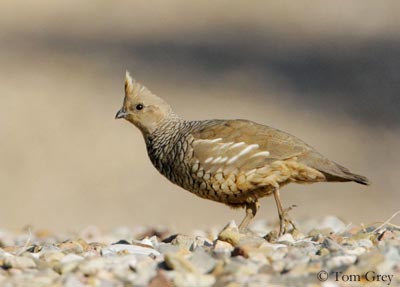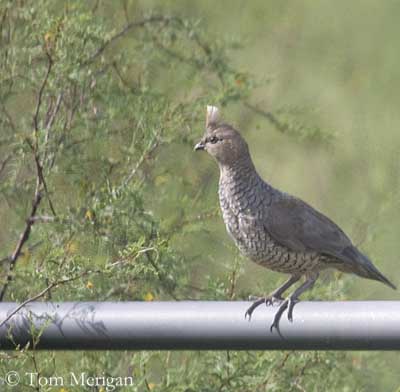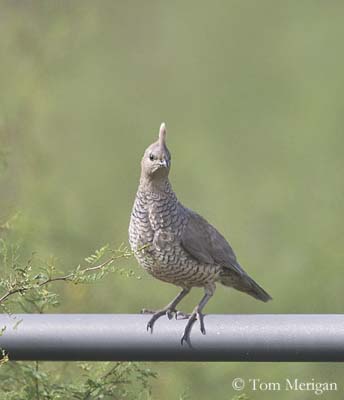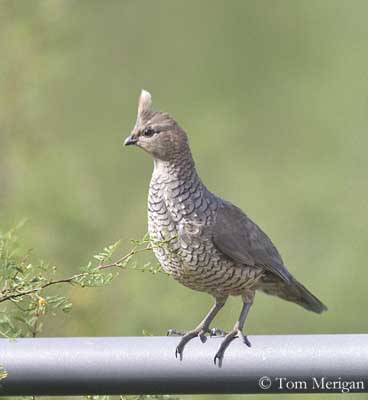
Fr: Colin écaillé
All : Schuppenwachtel
Esp : Colín Escamado
Ital: Quaglia azzurra
Nd: Geschubde Kwartel
Sd: Fjällig tofsvaktel
Photographers:
Grey Tom
Tom Grey's Bird Pictures
Merigan Tom
Tom Merigan’s Photo Galleries
Text by Nicole Bouglouan
Sources:
HANDBOOK OF THE BIRDS OF THE WORLD Vol 2 by Josep del Hoyo-Andrew Elliot-Jordi Sargatal - Lynx Edicions - ISBN: 8487334156
A GUIDE TO THE BIRDS OF COLOMBIA by Steven L. Hilty and William L. Brown - Princeton University Press – ISBN 069108372X
FIELD GUIDE TO THE BIRDS OF NORTH AMERICA - National Geographic Society - ISBN: 0792274512
What Bird-The ultimate Bird Guide (Mitchell Waite)
Wikipedia (Wikipedia, The Free Encyclopedia)
Scaled Quail
Callipepla squamata (race “pallida” displayed here)
Galliforme Order – Odontophoridae Family
BIOMETRICS:
Length: 22-29 cm
Weight: 150-200g
DESCRIPTION:
The Scaled Quail is a New World species. Its name comes from the scaly appearance of its plumage.
Adult male has blue-grey coloration, mainly on back, breast and belly, turning buffy below, with black-tipped feathers giving the scaled effect. The tail is grey. We can see a buff streaked white patch on folded wings and flanks.
On the pale buff head, there is a conspicuous short, brushy crest, buff to white, with white tip. The male has plain brownish chin coloration.
The bill is black. The eyes are dark brown. Legs and feet are dark grey.
The female has similar appearance but she has smaller crest, and shows fine brown streaks on face and throat.
The immature has tipped-buff greater primary coverts.
We can find four subspecies which differ in tone of grey on the upperparts.
The race “squamata” here described.
The race “castanogastris” is darker, with chestnut belly.
The race “pallida” (here displayed) is paler.
The race “hargravi” shows dusky streaks on the female’s throat.

VOICE: SOUNDS BY XENO-CANTO
The Scaled Quail’s territorial call is a repeated hoarse, wheezy “rrehh”. This call is sometimes alternated with dry, nasal, clicking “chow-chowk, chow-chowk”. It also utters dry, clucking “chek-ah”, and sharp, ringing “ching” as alarm call.
During the breeding season, both mates give contact calls when they are separated, a low, nasal “chip-churr”, with the second note more accented.
HABITAT:
The Scaled Quail frequents the arid and semi-arid brush and grasslands with scattered bushes. They are often seen close to standing water, and in cultivated areas.
RANGE:
The four races of the Scaled Quail share the range from SC Arizona, N New Mexico, EC Colorado and SW Kansas, and south through W Oklahoma, WC Texas into Mexico.
This species has been introduced in Hawaii, and is also well established in C Washington and E Nevada.
BEHAVIOUR:
The Scaled Quail feeds mainly on seeds, insects, some fruits and green grasses, but it takes a wide variety of food types. The seeds are taken from numerous plant species, and the insects are mainly beetles and grasshoppers.
It often feeds on seed in the early morning and the late afternoon.

They usually occur in pairs or small groups, but during fall and winter, they live in groups (coveys) of up to 20-50 birds or more. They roost together on the ground, in tight circle, tail to tail, for safety against predators.
As most of Galliforme species, the Scaled Quail prefers to run rather than take off when disturbed or threatened. It often runs for cover, but sometimes it can flush if surprised or too far from cover, and then, it runs again.
Outside the breeding season, they are gregarious and can occur with other quail species. They are very nervous birds and they run fast!
The pair-formation occurs in spring, in April. The male struts for females, but there is not aggressivity between rivals.
The displays are those of Galliformes, with frontal and lateral postures by males, accompanied by calls. However, these displays are less spectacular than those of Pheasants.
The Scaled Quail is sedentary, and only performs some movements according to the food resources.
FLIGHT:
The Scaled Quail is mainly a runner, and can reach speeds up to 20-24 km per hour. However, the quails are able to fly strongly with rapid wing-beats interspersed with glides, but only for short distances. The flight is fairly direct.

REPRODUCTION:
The Scaled Quail breeds during the rainy season, between June and October.
The nest is a depression on the ground, concealed under the shrubby vegetation or grasses.
The female lays 12-14 dull white eggs with brown and white markings. She incubates usually alone during about three weeks. The precocial chicks leave the nest within a day’ time, and at 12 days old, they are almost as big as their parents! They are sexually mature at one year old.
If the clutch is destroyed, a second brood will be laid.
Nest-failure is often due to bad weather, but also to predation by raptors and mammals. The overgrazing can also be a threat for the eggs.
DIET:
The Scaled Quail feeds primarily on seeds of sunflowers, cactus, green vegetation and numerous seasonal seeds, and some fruits.
It also catches insects such as beetles and grasshoppers.
PROTECTION / THREATS / STATUS:
The Scaled Quail is common and the populations are safe in spite of nest-predation by birds of prey and mammals, bad weather, overgrazing and regular hunting.
However, this species is not threatened at this moment.
